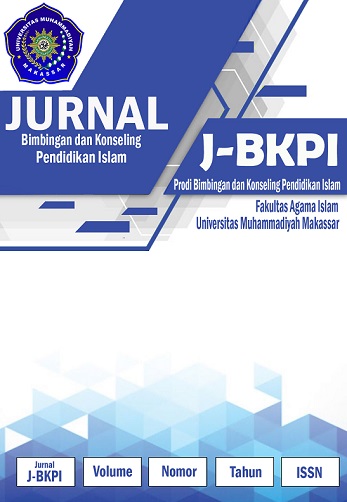Pengaruh Spiritual Emotional Freedom Technique (Seft) Dalam Menurunkan Kesepian Pada Warga Binaan Lapas Narkotika Kelas IIA, Kabupaten Gowa
DOI: https://doi.org/10.26618/jbkpi.v2i02.11458
Abstract
ABSTRACT
The separation of each prisoner from his family, the loss of work and environmental conditions as well as new forms of activity make prisoners vulnerable to loneliness. The purpose of this study was to determine the provision of Spiritual Emotional Freedom Technique (SEFT) therapy in reducing loneliness in prisoners. This study uses a quantitative experimental method with a randomized control group pretest-posttest design. The subjects in this study were 14 prisoners who were divided into 2 groups, the treatment group (mean = 10.93) and the control group (mena = 4.07). The results showed p = 0.002 (p < 0.05) for differences in the level of loneliness between groups, the significance value of p = 0.018 (p 0.05) for comparison of pretest (mean = 28.00) and posttest (mean = 20) values. .14) experimental group and p value = 0.18 (p>0.05) for the comparison of pretest (mean = 27.87) and posttest (mean = 27.42) in the control group. Based on the results, it was found that there were differences in the effect of giving SEFT in reducing loneliness. Other variables that can affect loneliness are suggested to be controlled more tightly or can be studied in depth in further research, such as personality, psychological conditions and prison environment.
References
Azwar, S. (2016). Penyusunan skala psikologi (Edisi 2). Yogyakarta: Pustaka Pelajar.
Cascio, C. N., O’Donnell, M. B., Tinney, F. J., Lieberman, M. D., Taylor, S. E., Strecher, V. J., & Falk, E. B. (2016). Self-affirmation activates brain systems associated with self-related processing and reward and is reinforced by future orientation. Social Cognitive and Affective Neuroscience, 11(4), 621–629. https://doi.org/10.1093/scan/nsv136
Cherry, K. (2019). The Health Consequences of Loneliness Causes and Health Consequences of Feeling Lonely. Website. Retrieved from https://www.verywellmind.com/loneliness-causes-effects-and-treatments-2795749
Dimitrov, D. M., & Rumrill, P. D. (2003). Pretest-posttest designs and measurement of change. Work, 20(2), 159–165.
Hosseinbor, M., Yassini Ardekani, S. M., Bakhshani, S., & Bakhshani, S. (2014). Emotional and Social Loneliness in Individuals With and Without Substance Dependence Disorder. International Journal of High Risk Behaviors and Addiction, 3(3), 3–5. https://doi.org/10.5812/ijhrba.22688
Howell, A. J. (2017). Self-Affirmation Theory and the Science of Well-Being. Journal of Happiness Studies, 18(1), 293–311. https://doi.org/10.1007/s10902-016-9713-5
Iskandar, E. (2010). The Miracle of Touch. Bandung: Penerbit Qanita PT Mizan Pustaka.
Mushtaq, R., Shoib, S., Shah, T., & Mushtaq, S. (2014). Relationship between loneliness, Psychiatric disorders and physical health ? A review on the psychological aspects of loneliness. Journal of Clinical and Diagnostic Research, 8(9), WE01–WE04. https://doi.org/10.7860/JCDR/2014/10077.4828
Perlman, D., & Peplau, L. A. (1981). Toward a Social Psychology of Loneliness. In S. Duck & R. Gilmour (Eds.), Personal relationships in disorder (pp. 31–56). London: Academic Press. Retrieved from https://peplau.psych.ucla.edu/publication/Publications_files/Perlman %26 Peplau 81.pdf
Perlman, D., & Peplau, L. A. (1998). Loneliness. In H. S. Friedman (Ed.), Encyclopedia of Mental Health (Vol. 2, pp. 571–581). San Diego: Academic Press. Retrieved from https://peplau.psych.ucla.edu/wp-content/uploads/sites/141/2017/07/Perlman-Peplau-98.pdf
Priyatno, D. (2012). Belajar praktis analisis parametrik dan non parametrik dengan spss. Yogyakarta: Gava Media.
Rokach, A. (2004). Loneliness then and now: Reflections on social and emotional alienation in everyday life. Current Psychology, 23(1), 24–40. https://doi.org/10.1007/s12144-004-1006-1
Rokach, A., & Koledin, S. (1997). Loneliness in Jail: A Study of the Loneliness of Incarcerated Men. International Journal of Offender Therapy and Comparative Criminology, 41(2), 168–179. https://doi.org/10.1177/0306624X97412008
Rokach, A., & Neto, F. (2000). Causes of loneliness in adolescence: A cross-cultural study. International Journal of Adolescence and Youth, 8(1), 65–80. https://doi.org/10.1080/02673843.2000.9747842
Rotenberg, K. J., Addis, N., Betts, L. R., Corrigan, A., Fox, C., Hobson, Z., … Boulton, M. J. (2010). The relation between trust beliefs and loneliness during early childhood, middle childhood, and adulthood. Personality and Social Psychology Bulletin, 36(8), 1086–1100. https://doi.org/10.1177/0146167210374957
Russell, D. W. (1996). UCLA Loneliness Scale (Version 3): Reliability, Validity, and Factor Structure. Journal of Personality Assessment, 66(1), 20–40. https://doi.org/10.1207/s15327752jpa6601_2
Setyo, F. G. (2018). Hubungan antara dukungan sosial dengan kesepian pada narapidana kasus narkotika Lapas Kelas IIA Sungguminasa Gowa. (Skripsi). Makassar: Universitas Negeri Makassar.
Zainuddin, A. F. (2006). Spiritual emotional freedom technique (SEFT) for Healing Success Happiness Greatness. Jakarta: Afzan Publishing.
Zulfiana, A. (2015). Terapi spiritual emotional freedom technique untuk menurunkan kesepian pada remaja di lembaga kesejahteraan sosial anak. (Skripsi). Makassar: Universitas Negeri Makassar. Retrieved from http://eprints.unm.ac.id/5116/1/SKRIPSI.pdf










